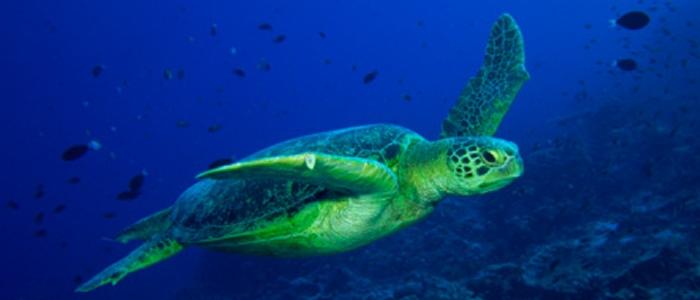
Reproduction
The sexual maturation of the green turtle is reached between 15-50 years (Lemm, 2006).The average rate of growth for Green sea turtles has been found to be 20 cm per year whereas maturity for females is said to be reached at 88 cm in length (Pope, 1971). When green turtles find a mate, they often migrate near nesting shores (Magnuson et al., 1990). During copulation, the mating pair of green sea turtles float on the surface of the ocean, oblivious to the potential dangers (Pope, 1971).

Females lay their eggs on the beaches of many islands where they dig holes called nests during the night (Encyclopedia, 2013). The females look for large beaches with little to no disturbances and a downward slope to the ocean (U.S., 2013). Despite the effort put forth by the females, not all nests survive nature. Many nests are destroyed due to the changes in tide. Nests either become flooded with water, become uncovered by erosion, or both (Magnuson et al., 1990).
Reproduction occurs every 2-4 years and females rarely produce more than one clutch in consecutive years (U.S., 2013). A clutch is a nest of eggs and on average a female will lay 9 clutches at 13 day intervals with around 75-200 eggs per clutch (U.S., 2013). Eggs are 4.0-4.6 cm in diameter (Lemm, 2006). The process of laying eggs takes a female green turtle approximately two hours (Magnuson et al., 1990). Time of incubation is variable from 45-75 days depending on the temperature during this period (U.S., 2013).
Sex of the hatchlings depends on the temperature at which the eggs are incubated (Magnuson et al., 1990). Due to the sex depending on temperature at incubation, clutches tend to consist of one sex (Alderton, 1988). Composition of the sand where females lay their eggs can cause variations in the incubation temperatures along with depth and humidity (Alderton, 1988). Clay based sands tend to have a lower temperature and therefore affect the sex of the hatchlings (Alderton, 1988). Differences in humidity can have the same sex and female turtles are known to pee on the clutch to raise the humidity which needs to be around 80% for proper incubation (Alderton, 1988).
 Nesting occurs at different times of the year depending on the location. On a group of islands called Seychelles, peak
times of nesting is between March and May, where-as-in Borneo, nesting
peaks occur between May and September (Pope, 1971). In the southeastern United
States, the nesting occurs between the months of June to October (Lemm,
2006). Once hatched, the young crawl into the ocean and those that survive
can live up to 80 years of age (Encyclopedia 2013).
At birth, they are 5 cm in length (Lemm, 2006). Newly hatched young are black in color until six
months of age when they become much paler (Conant, 1975).
Nesting occurs at different times of the year depending on the location. On a group of islands called Seychelles, peak
times of nesting is between March and May, where-as-in Borneo, nesting
peaks occur between May and September (Pope, 1971). In the southeastern United
States, the nesting occurs between the months of June to October (Lemm,
2006). Once hatched, the young crawl into the ocean and those that survive
can live up to 80 years of age (Encyclopedia 2013).
At birth, they are 5 cm in length (Lemm, 2006). Newly hatched young are black in color until six
months of age when they become much paler (Conant, 1975).